Membrillo (Sweet Quince Paste)
This post may contain affiliate links. See my disclosure policy.
Popular throughout many countries, membrillo (aka, quince paste or quince cheese) is incredibly versatile and one of the most delicious confections you’ve ever tasted! It also makes an excellent and unique gift for friends and family who appreciate good food. This membrillo recipe is easy to make and freezes well so you can conveniently have it on hand whenever you have friends over or are in the mood for a delicious snack!
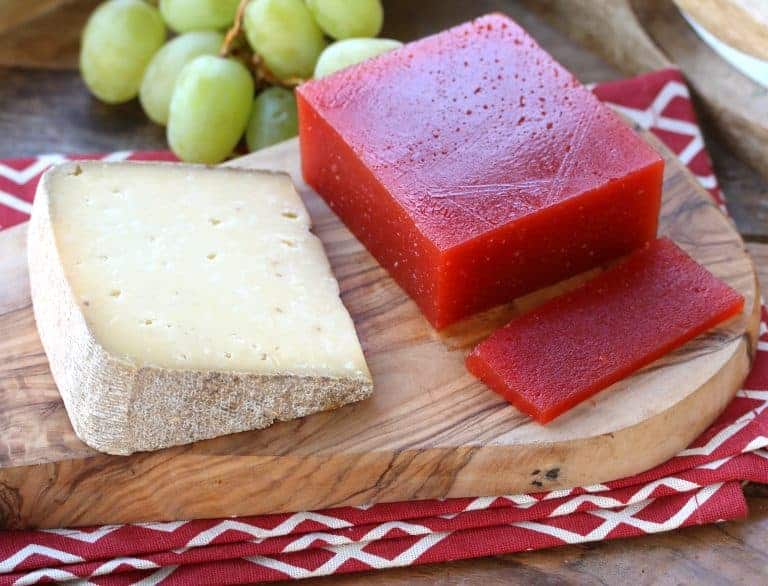
What is Quince?
The quince fruit has been prized since ancient times and up until around the early 19th century was still found in the garden of many homes. As long ago as 1922, the great New York pomologist U. P. Hedrick rued that “the quince, the ‘golden apple’ of the ancients, once dedicated to deities, and looked upon as the emblem of love and happiness, for centuries the favorite pome, is now neglected and the least esteemed of commonly cultivated tree-fruits.”
Though highly revered for so long, it has sadly fallen out of favor to the point where few people have even heard of it let alone tasted one. How that happened I can’t imagine because it is one of the most under-appreciated and spectacular fruits out there.
Though it is in the same family as apples and pears, the quince is practically inedible raw, no matter how ripe, and has to be cooked. And though it is considered less versatile than apples and pears, and is challenging to find anymore, it has such an incredible and unique flavor it is worth every effort to find it.
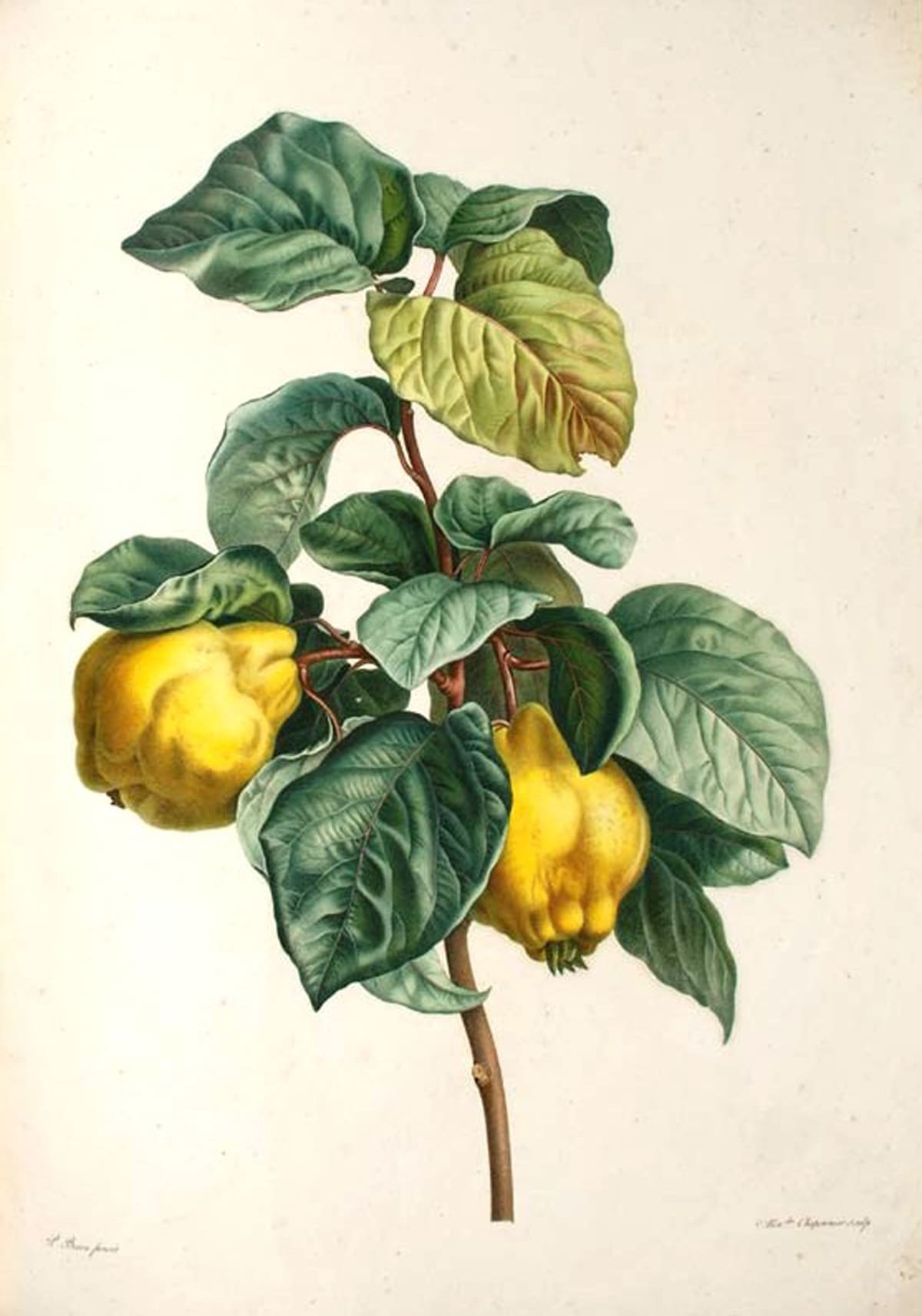
Some grocery stores carry it during the Christmas season but you’ll likely need to ask the produce manager to order some for you. My solution was to plant a quince tree a couple of years ago and eagerly look forward to the first fruits next year!
Today we’re making what is probably the most famous application of the quince besides quince jelly: Membrillo.
What is Membrillo?
Membrillo is a sweet, thick, sliceable firm paste made from quince that originated in Spain and is especially popular during the Christmas holidays. It is now a popular confection in many countries. It’s also known as Dulce de membrillo (Spain, Ecuador, Argentina, Chile, Mexico, Uruguay), marmelada (Portugal, Brazil), pâte de coing (France), Quittenkäse (Germany), birsalmasajt (Hungary), and quince cheese (New England) or quince paste (UK, Canada, Australia), to name a few.
The quince has been a highly revered fruit since ancient times and this recipe is thought to have Roman origins as early as the 4th or 5th century AD and used honey instead of sugar.
Quince paste is usually sold in squares and is served by cutting it into thin slices to accompany cheese (in Spain, membrillo and manchego cheese are inseparable), served on crackers, spread on toast or sandwiches, served with breakfast, eaten plain as a sweet confection (and commonly rolled in sugar), served with meats, and is also used to stuff pastries and spread in cakes.
I’ll never forget the first time I tried membrillo. It was also the first time I had ever tried quince. Oh, the aroma and the flavor! It’s among the most unique and wonderful smells and flavors I’ve encountered. It’s hard to describe. It’s not anything like apple or pear. The best word I can think of to describe the flavor is sweetly floral. It has a highly aromatic, floral flavor, almost like it’s made with essential oils of wild English roses. After having tasted quince, I now understand why quince in ancient times was considered a fruit of the gods. It is divine.
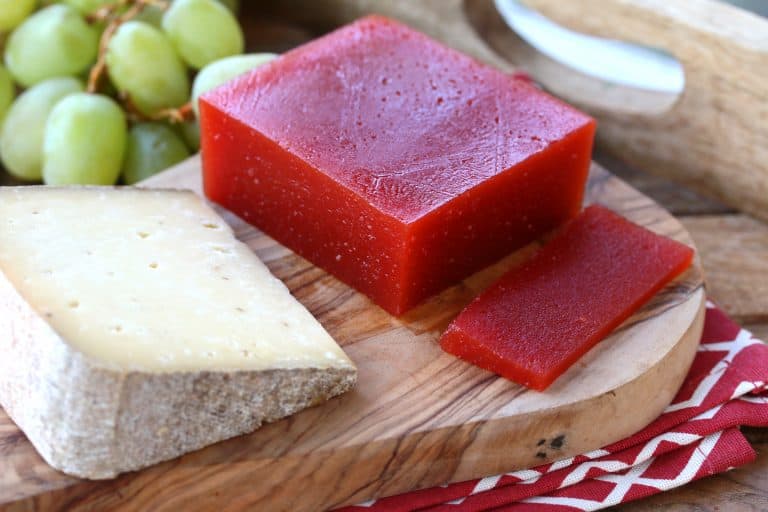
How to Make Membrillo
Making membrillo is extremely easy. Many recipes call for cooking the quinces whole, then straining the water, then peeling and coring them, then weighing the pulp and then simmering it with sugar. None of that extra fuss is remotely necessary.
First of all, the quince flesh itself is so high in pectin that simmering it with the peels and seeds is unnecessary. Not only that, leaving the skins on will result in a membrillo that is slightly browner in color. Just peel and core your quinces from the start and throw the diced quince directly into the pot with the sugar and water. Secondly, there is no need to strain the water and then weigh the pulp. Simply weigh the peeled, cored quince at the start and add it to the pot with the sugar and a little water. Stew the quince and then simply puree the mixture and let it set. That’s it. The result will be a firm membrillo with a perfectly sliceable consistency and heavenly flavor!
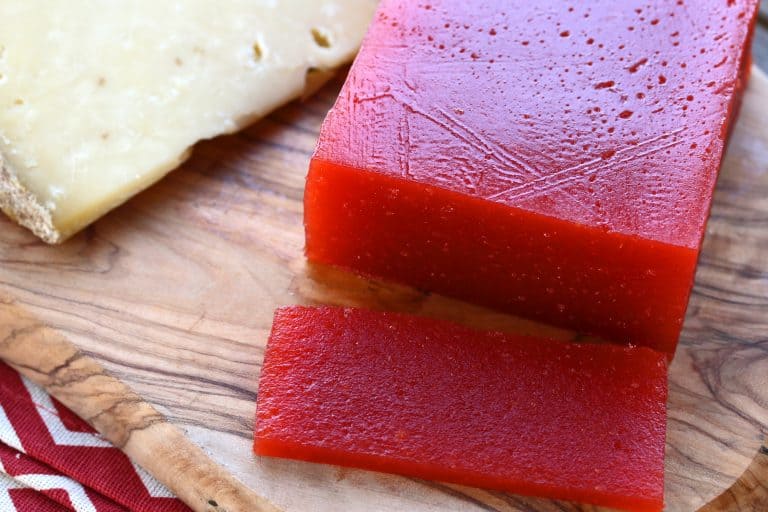
How Long Does Membrillo Keep?
Membrillo keeps for a long time, which is a big plus. Like jam, the sugar acts as a preservative and it will keep in the fridge for at least 3 months. In many areas of the world it’s kept at room temperature for the same length of time. It also freezes well for even longer storage.
How to Serve Membrillo
Membrillo is typically served at room temperature sliced or cubed. It’s often served as an appetizer or dessert and is paired with cheese, crackers or bread or as part of a cheese and charcuterie board. Serve membrillo with hard and semi-hard cheeses like Manchego, a classic pairing.
Alternatively, membrillo can also be used as an ingredient in various dishes, such as a filling for tarts and pastries, or as a glaze for meats.
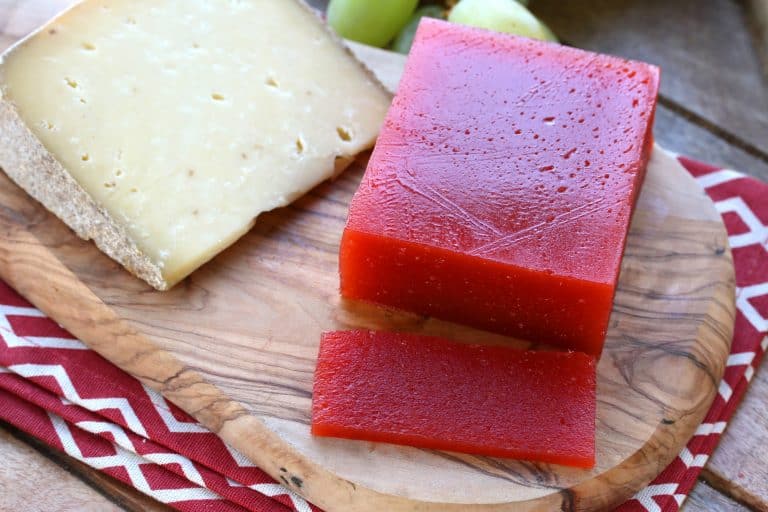
Membrillo Recipe
Let’s get started!
Select ripe, fragrant quinces.
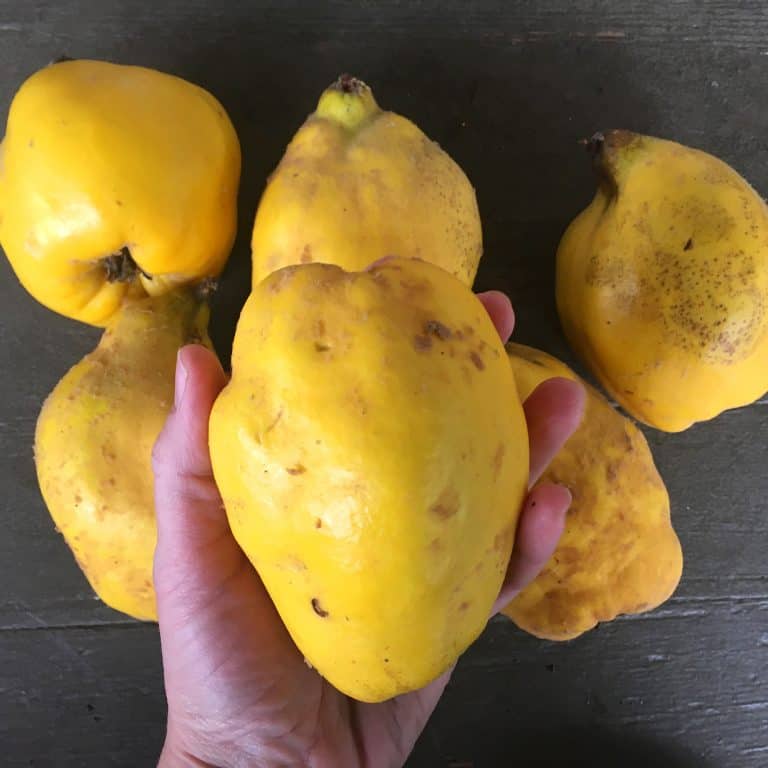
Wash and remove any of the fuzz from them. Peel and core the quinces and dice into 3/4 inch pieces.
They will turn brown quickly, that is perfectly okay.
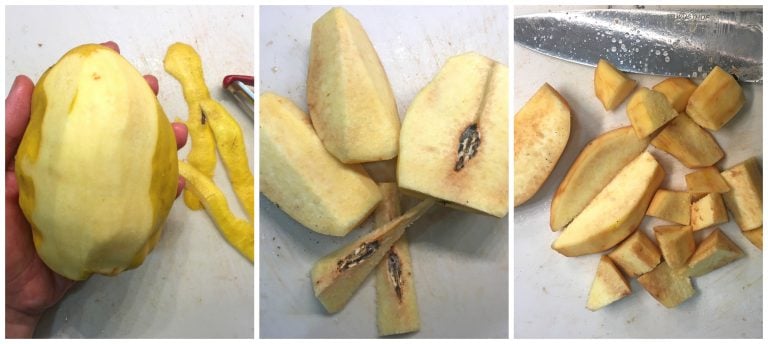
Place the diced quince in a medium pot over medium heat along with the sugar, lemon juice and water.
Bring the mixture to simmer, stirring occasionally to melt the sugar.
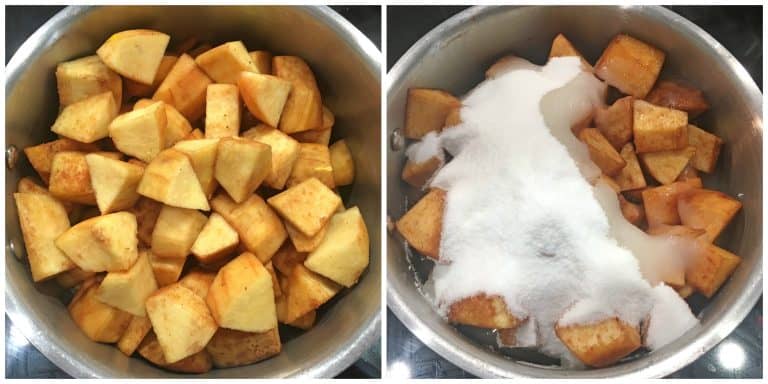
Continue to simmer over medium heat for an hour or so, stirring occasionally.
During this time the quince will progressively turn into a beautiful ruby red color.
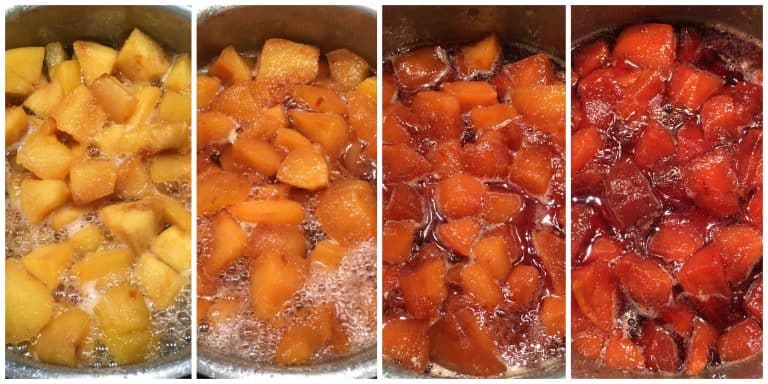
Simmer until a candy or instant-read thermometer reads 220 degrees F. This doesn’t always guaranteed it’s ready, so at this point also do a plate test to make sure the mixture is done: Spoon a little of the liquid onto a cold plate and wait a couple of minutes. Push the liquid with your finger and if it wrinkles it is ready. If it doesn’t, continue to simmer and re-test.
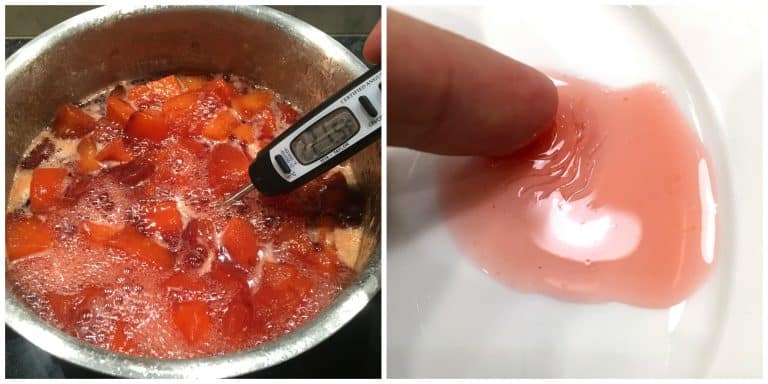
Grease a 8×8 inch glass baking dish.
Puree the mixture with an immersion blender or blend in a Vitamix or similar until smooth.
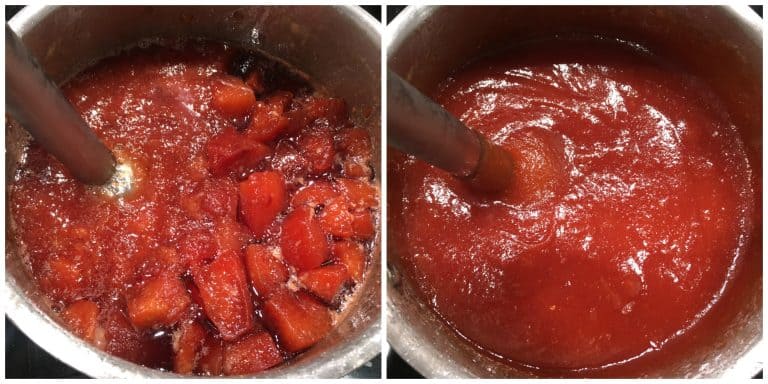
I find the immersion blender is adequate but if you want the mixture even smoother, transfer it to a Vitamix (or similar).
Pour the hot mixture into the greased baking dish.
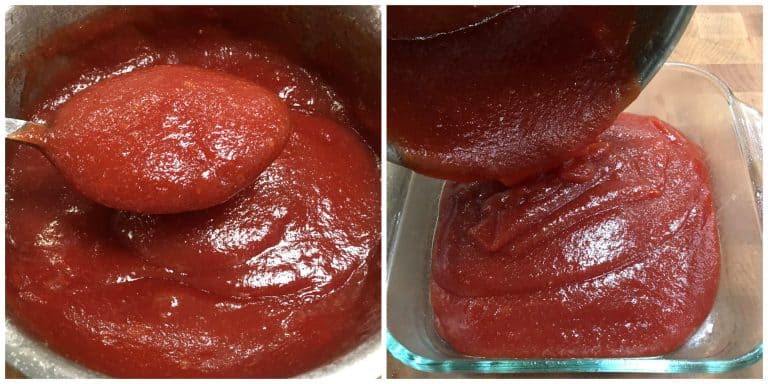
Use the back of a spoon to smooth the top. Let it cool to room temperature, then cover with plastic wrap and refrigerate for 24-48 hours until firm. Invert the membrillo / quince paste onto a platter (you may need to gently pry it out with a knife).
Note: Some recipes call for placing the membrillo in an oven at low temp (125 degrees F) for 8+ hours to firm it up. This membrillo is already firm and perfectly sliceable. If you prefer it even firmer, proceed with dehydrating it.
Cover with plastic wrap and store in the fridge for up to 3 months or longer. For longer storage membrillo can be frozen well-wrapped for up to a year.
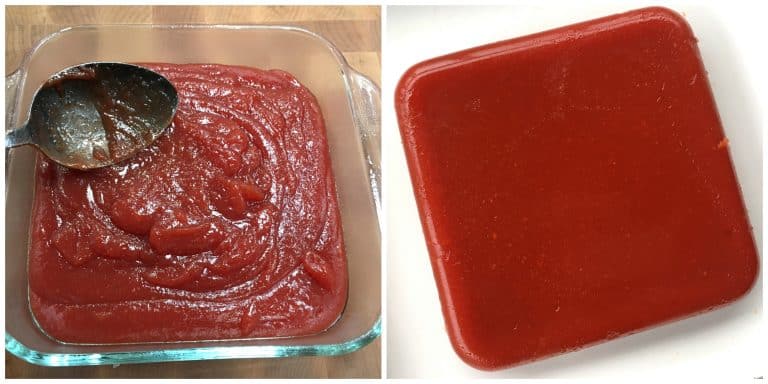
Enjoy!
Serve with your cheese & charcuterie board. Traditionally served with manchego but pairs beautifully with most aged, hard cheeses.
Alternatively, you can also cut the membrillo into small squares and dehydrate them at low temp for a while in the oven to firm them up, then roll them in sugar as a sweet confection.
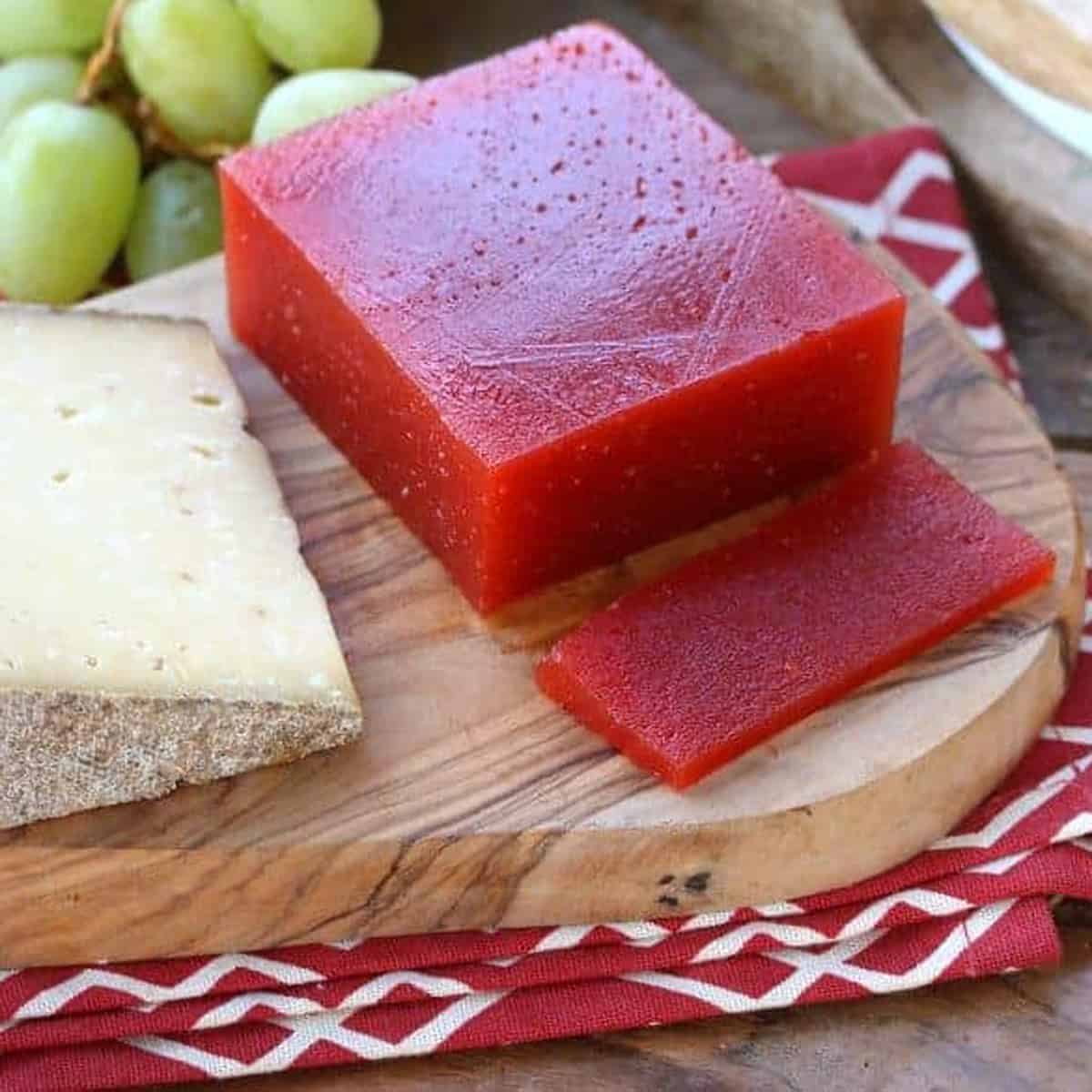
For more delicious recipes to feature on your cheese and charcuterie board, be sure to try my:
- Chicken Liver Pate
- Capicola
- Toasted Hazelnut and Date Spread
- Black Olive Tapenade
- Pork Rillettes
- Smoked Salmon Spread
- Pimento Cheese
- Pickled Asparagus
- Pickled Pepperoncini Peppers
- Pistachio Lemon Cheese Balls
- Creole Mustard
- How to Create a Cheese and Charcuterie Board
Save This Recipe
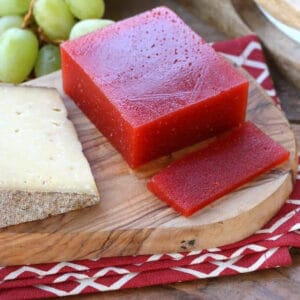
Membrillo (Sweet Quince Paste)
Ingredients
- 2.25 pounds quince , washed (remove any of the fuzz), peeled, cored and diced in 3/4 inch chunks (total weight is *after* peeling/coring) (if quince is unavailable, ask the produce manager if they can order it)
- 3 1/2 cups white granulated sugar
- 2 tablespoons lemon juice
- 1 cup water
Instructions
- Place all the ingredients in a medium pot over medium heat. Stirring occasionally, once the sugar has melted and the mixture begins to bubble, simmer uncovered for an hour or so, stirring occasionally, until the candy thermometer reads 220 degrees F. This doesn't always guaranteed it's ready, so at this point also do a plate test to make sure the mixture is done: Spoon a little of the liquid onto a cold plate and wait a couple of minutes. Push the liquid with your finger and if it wrinkles it is ready. If it doesn't, continue to simmer and re-test. The quince will increasingly change into a deep ruby red color.
- Grease a 8×8 inch glass baking dish. Puree the mixture with an immersion blender or blend in a Vitamix or similar until smooth. Pour the hot mixture into the greased baking dish and smooth the top. Let it cool to room temperature, then cover with plastic wrap and refrigerate for 24-48 hours until firm. Invert the membrillo / quince paste onto a platter (you may need to gently pry it out with a knife). Note: Some recipes call for placing the membrillo in an oven at low temp (125 degrees F) for 8+ hours to firm it up. This membrillo is already firm and perfectly sliceable. If you prefer it even firmer, proceed with dehydrating it.Cover with plastic wrap and store in the fridge for up to 3 months or longer. For longer storage membrillo can be frozen well-wrapped for up to a year. Makes one 8×8 inch square of quince paste.Serve with hard and semi-hard cheeses (Manchego is classic) and bread and crackers.
Notes
Nutrition
Originally published on The Daring Gourmet November 18, 2018



















Great recipe. It does not freeze. My husband discovered that.
I’m glad you enjoyed it, Rita, thanks for the feedback! I’m puzzled about the freezing, I’ve frozen this many, many times…?
Great recipe. Worked first time. Set up nicely in the fridge. I did need to cook it down more like 3 hours, but I also may have put more than a cup of water. I also added twice the amount of lemon juice. Turned out really well. Thank you
I’m so glad, Winscene, thank you very much for the feedback!
Hi there, I’m going to be making your recipe tomorrow.
Do I need to keep the quince peel & add to the pan, as I hear it contains lots of pectin ?
Kind regards, Claire 😊
Hi Claire, no you do not need to leave the peels on and I recommend against doing so. The quince flesh itself is so high in pectin that simmering it with the peels and seeds is unnecessary. Further, leaving the skins on will result in a membrillo that is slightly browner in color. Happy cooking!
Tried it. First the bottom burned. Put what I had in a new pot, pureed it, reheated but could only get to 80°C without huge eruptions of hot puree. Put it out to cool anyway, it set but not hard enough. Dried it out in the oven on minimum. Worked fine, and the end product was at least as good as the membrillo I made the traditional way. By the way, I use forage quinces, remove the cores and any daggy bits but leave the skins on. Hopefully, later today I’ll try another batch but this time make it much thinner (2-3mm) and dry it out more to make it into leather (which I’d use more of, taking it as a hiking snack). Overall, good recipe.
Brilliant recipe. Always takes longer than 1 hour to simmer for me but otherwise turns out perfectly every time. Gorgeous with blue cheeses!
I’m writing from northern New England USA and in our rural area quinces are nearly impossible to find – and wildly expensive when i’ve seen them. To shop judiciously, can you give me a ballpark weight range as to how many pounds of unprepared quinces i would need to definitely have 3 pounds of prepared fruit, ready for the pot? I’d much rather have too much than too little. Thank you for any help you can give. -AO.
Can you pot the membrillo like jam, and if so, would you need to water bath it afterwards ?
Easy? Has anyone really cut and peeled quinces? It’s like shucking oysters. I think that could be one reason no one uses them. That said I have made variations of quince, jelly, marmalade, and membrillo (once). Worth it? I guess. Let’s just say I dread the years our bushes are full of fruit.
It turns out there is no need to peel or core the quince. Slice into small pieces, cook cook cook. The pectin is in the peel which makes it firm up. I started with 3.5 pounds fruit and 8 cups water. I ended up with 5 cups of clear jelly.i saved one cup of juice and cooked it with 5 cups of mash I squished through a sieve. After hours of drying, it made a bunch of fruit leather. Work, but tasty.
I made this twice and absolutely love it! Easy to make and super delicious! I went a bit nought and added 50ml of Irish whiskey before transferring it into the tray. I will be giving it as a presents this Xmas!
Fantastic, Monika, I’m glad you enjoyed it and appreciate the feedback!
Greetings–Have you tried using a pressure cooker in lieu of boiling to speed up the process. Also is a pressure cooker too hot for quince pectin and likely to damage its ability to gel the quince paste. Thanks
Hi Mark, I haven’t tried it but my understanding is that a pressure cooker will definitely break down the pectin so I wouldn’t recommend going that route.
This is the only recipe to use for membrillo. Worked perfectly and so simple. No faffing. Thank you so much. Set up for Christmas!
Wonderful, IIknur, thank you so much! :)
Made this today. Can’t wait to taste it! Can you please tell me how long it keeps in the refrigerator? Can you freeze it? Much appreciated.
Hi Maria, it will keep in the fridge for about 3 months and can also be frozen for up to a year (wrap it really well).
Made today using about 20 lbs of quince. Don’t even guess how much sugar that required… :) Turned out absolutely perfect after simmering for a few hours! 100% “membrillo set” – I may decide to slice and sugar as suggested…
Lol, WOW, that’s a lot of membrillo, Claire!! :) I’m so happy it was a success, thank you for the feedback!
Make this every year .. it’s fantastic. Makes a lovely homemade gifts as well for friends & family. True, quince is hard to find in shops but if you have a garden , it’s easy to grow. In the first year it grew 6 quinces , this year I had 24 ! Quince flowers beautiful in spring as well.
I have used this recipe often and love it.. I add some jalapeño and lime juice to some batches for an even more exotic punch..Our quince trees are MASSIVE fruit producers! even after a justa few years.. PLANT ONE!
Thank you so much, Mark! We planted two quince trees at our last house and when we moved to our new location a year ago we planted two quince trees again. We love them!
Sure would like to know more about growing quince trees. I have a very old wild quince tree. Makes fantastic paste but tree is dieing in sections. Not sure how to propagate a new one or where to buy another. How long before new trees produce fruit? Thanks!
Hi Kelly, it’s so hard losing fruit trees to age when they’ve been so reliable! We’ve experienced that with our apple and pear trees and it’s a long wait for the new trees to start producing. I don’t know a whole lot of about propagating when it comes to grafting onto rootstock. We bought ours from nurseries. I’d recommend calling all the nurseries within reasonable driving distance to see if they carry them. If not, you can also order quince trees online.
Bay Laurel Gdn Center in Atascadero CA ships bare root trees, but you have to order early in fall, usually. They have a website for ordering. good luck. they carry many exotic or unusual fruits. I worked there many years ago. good people.
Thanks for this recipe. I made it today and the results were right up there with the professionals. My wife is Uruguayan and dulce de membrillo very popular there. I planted a quince tree around a year ago and used the first harvest of fruits today. She loved it and thought it was as good as any she’s ever had. She’s aiming to make some pasta frola with it as well as eat it with cheese as you suggest (this is called Martin Fierro in Uruguay). Thanks again from us both 😊
That’s wonderful, Steve, thanks so much for the feedback and congratulations on your first harvest of quince from your tree!!